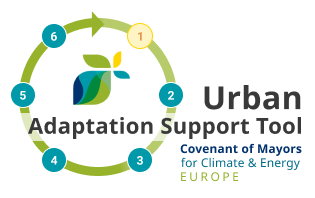
Preparing the ground for adaptation
1.5 Identifying and obtaining financing and funding
Funding of adaptation refers to money provided free of charge by public or private bodies (e.g. foundations) towards the implementation of a specific adaptation policy goal or agreed purpose, e.g. as a grant. A repayment of the provided capital is not required, however there are specific contractual requirements to ensure the funds are used as intended. Financing on the other hand refers to the provision of capital with the liability to repay at a later stage (debt instrument) and usually incurs a "cost" - percentage of interest. It is usually provided as a loan or other type of financing instrument, commonly by a financial institution.
Funding and financing for adaptation on the municipal level in Europe is available through several EU funding instruments, national, regional and local funds, as well as from international financing institutions, and private donor organisations:
- Adaptation to climate change is one of the LIFE programme priority areas. The programme provides co-financing for best practice, pilot and demonstration projects that contribute to supporting efforts leading to increased resilience to climate change, including specifically in urban areas.
- Horizon 2020, the EU's programme for research and innovation, aims to allocate 35% of its budget to climate-related research expenditure. It also requires end-user and stakeholder involvement, which opens the doors for city involvement. It will be followed in 2021 by Horizon Europe, which also includes a topic area on climate change adaptation. In 2020, an additional European Green Deal call is launched with topics relevant to climate change adaptation.
- Adaptation to climate change is mainstreamed throughout EU’s European structural and investment funds (ESIF). Those include the CAP (mainly the European Agricultural Fund for Rural Development); the Cohesion fund; the European Regional Development Fund (particularly through INTERREG), the European Social Fund; and the European Maritime and Fisheries Fund. National authorities are in charge of managing these funds in the respective Member State and can be approached for further advice.
- National and sub-national funding: On the national and sub-national levels funding may be available both for adaptation planning and implementation, awareness and capacity building or research.
- Private sector funding: The private sector is an important stakeholder in adaptation to climate change risks, with high motivation for adaptation action. Private sector adaptation action is driven by: a) value protection motives when private actors seek to protect their assets and supply chains, b) value creation opportunities when the private sector seeks to provide adaptation solutions as business opportunities. Local governments are, therefore, encouraged to seek cooperation with the private sector (such as through public-private partnerships) to leverage the private sector funding.
- Adaptation financing can also be supplemented by loans from such financial institutions as the European Investment Bank or the European Bank for Reconstruction and Development.
- Municipal green/climate/sustainability bonds are rapidly emerging as an instrument for attracting financing for adaptation actions in cities. The set-up and emission of green bonds requires close collaboration with financial market entities.
- Furthermore, the insurance sector is an important private sector player that can provide incentives for businesses and households for investing in climate resilience.
- Some cities have pioneered crowdfunding or private donation approaches to adaptation, whereas citizen initiatives propose adaptation actions in a bottom-up manner, which are then advertised to the community willing to donate or lend funds towards implementation of the proposed actions. This way small individual donations sum up to considerable funds sufficient for action implementation.
- Household own funds: Private households are often willing to ensure the resilience of their housing and wellbeing of the family by planning their expenses and investments in a more adaptive manner (e.g. investing in better insulation when renovating houses or installing rainwater collection for garden watering during drought periods). Awareness raising, education and nudge incentives are useful tools to incentivise private household investment. Local authorities in some countries also revert to tax or fee abatement schemes as incentives, e.g. reducing stormwater fees they charge property owners if they in turn invest in measures to reduce rainwater runoff from their property into the public drainage system.
- Moreover, adaptation-relevant funding can be obtained through other sectoral funding mechanisms, in which case it may not necessarily be labelled "adaptation funding", however, may still contribute to adaptation policy aims.
Flexibility and a combination of various funding and financing sources are advisable, especially in cases where dedicated municipal budget lines may be hard to secure. Furthermore, tapping into non-monetary support (see Step 1.8) can relieve the pressure on funding requirements.
Examples of cities throughout Europe successfully employing these funding and financing sources for adaptation are listed below and are described in detail in EEA report on financing urban adaptation. The report also provides a detailed overview of the available EU funding and financing sources for urban adaptation. See also Chapter 5 of the EEA report Urban adaptation in Europe: how cities and towns respond to climate change for further information.

Additional overviews of available adaptation funding in the EU are provided in the funding section of Climate-ADAPT as well as on the EU website for regional and urban development.
